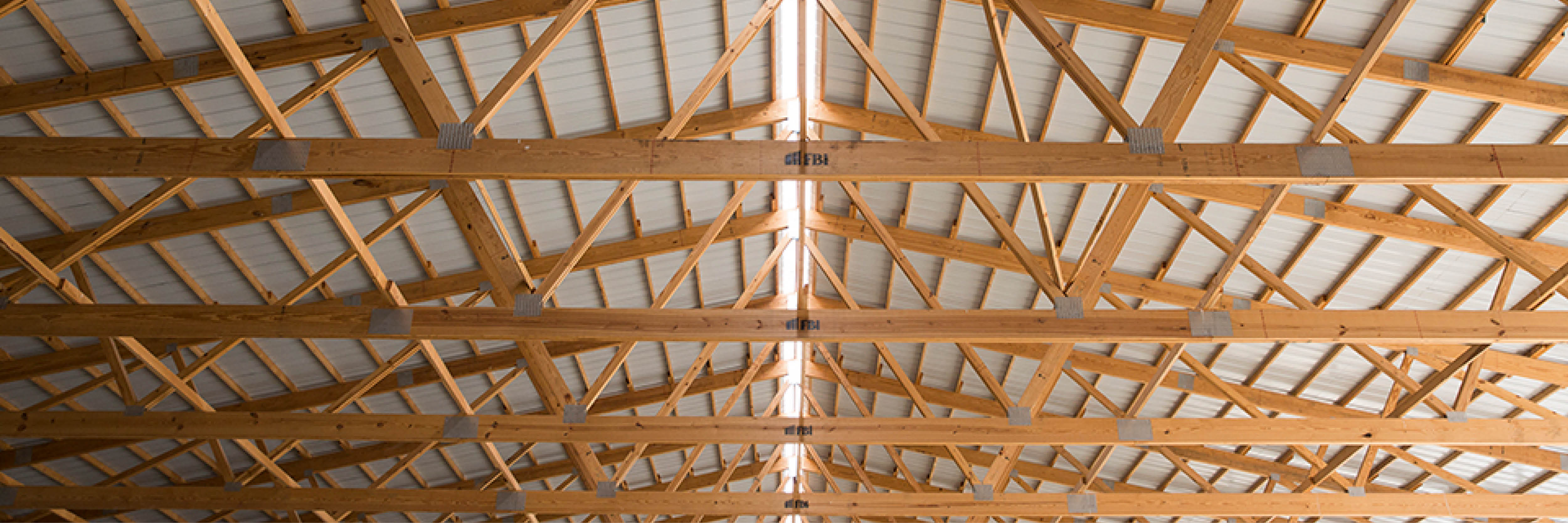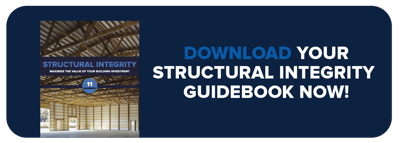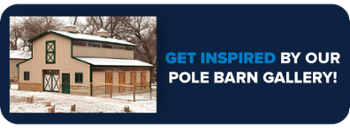Building Features | Structural Integrity | Comparisons
Rafters vs. Pole Barn Trusses: What’s the Difference?
Angie joined FBi Buildings in 2012 and is now the Director of Marketing. She's an avid reader and enjoys outdoor leisure and cheering on her two daughters at their sporting events.
Rafters vs. trusses. Two different words that can easily be confused with one another (especially if you’re a construction newbie). Although both types of components are used to support the roof of a building, they each have their place in post frame construction. Before we dive deep into the differences, let’s cover the basics. Rafters and trusses both:
- Support the roof of a building (whether it be a post frame building or a stick-built home)
- Are made out of wood (very rarely is a different material used, unless you’re looking for a steel frame structure)
- Are triangular (I’ve never seen a square truss before, have you?)
In this article, we’ll help you understand the differences between rafters and trusses and typical construction uses between the two (who knows, maybe you’ll learn something new along the way).
Before we dive deep into the comparisons, let’s start with the basic definitions.
What is a Rafter?
Rafters are commonly used when you want to maximize the space of a structure. For example, if you’re looking to have steeply vaulted ceilings or extra storage clearance, you’re building a pole barn.
From a construction method, rafters can be single or double-ply. They only use one framing member (there is no bottom chord or webbing). Rafters can be used in the primary structure (meaning no trusses). However, if you decide to use rafters as your primary support, you will need additional headers or interior supports.
What is a Pole Barn Truss?
A truss is the rigid framework of wooden members designed to support a roof. Trusses are comprised of a top chord, a bottom chord, and webs connected at the joints with plates.
The actual truss profile, spacing, span, heel height, pitch, overhang, and web configuration are dependent on the specific design conditions and will vary by application.
Now that you have a basic understanding of rafters and trusses let’s discuss why trusses are primarily used for post frame construction. This doesn’t mean that rafters aren’t a viable option, but rafters will affect the overall layout of your building.
Interested in building a pole barn home? Check out our FREE Ultimate Guide to Building a Barndominium.
What Are the Differences Between Rafters and Trusses?
If you’re contemplating building a new pole barn, you’ve more than likely have done your research on post frame builders in your area. You might even have it narrowed down to your top two favorite builders. If you’re an avid follower of FBi Buildings, we’ve even written a blog over 6 Key Points to Look For in a Quality Post Frame Builder.
If you’re undecided about what roof system to use (wood trusses, roof trusses, steel trusses, etc), these six key areas listed below will provide you with more information for your construction project.
1) Construction Method
We consistently cover the importance of high-quality materials and how structural integrity plays a role in the longevity of your post frame building. But, of course, the construction of your roof support is at the top of that list.
Rafters
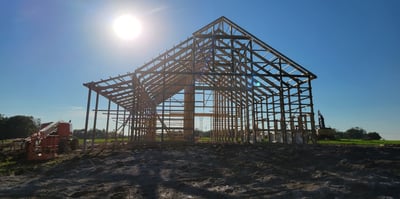 Rafters are a convenient option if you’re looking at building a smaller project that doesn’t require a wide span. They’re also ideal for smaller, DIY pole barn kits.
Rafters are a convenient option if you’re looking at building a smaller project that doesn’t require a wide span. They’re also ideal for smaller, DIY pole barn kits.
Rafters can also be used for horse barns. Remember when we said that rafters need additional interior support? The stalls inside your building help make up that extra support.
If you choose to go this route (and choose FBi as your builder), we will incorporate a rafter-truss combo for your building. The “truss” portion of the building would be your aisle way, and the “rafter” would be at the top of the structure.
As previously stated, rafters can be single or double-ply. They’re constructed with only one framing member (meaning no bottom chord or webbing). They’re often used on unfinished porches, lean-tos, or horse barns.
However, lumber only comes in 20’ increments. With trusses, you can splice the members in a truss design. FBi’s trusses are engineered, so we would make sure that the number of splices would not interfere with the integrity of your building. This is not as easy with rafters because of less support with the bottom chords.
Trusses
 On the flip side, the beauty of a pole barn is how it’s constructed. Because of the trusses, post frame buildings can have large interior spaces. They’re also extremely flexible in design. Check out some of our commercial buildings to see what we’re talking about.
On the flip side, the beauty of a pole barn is how it’s constructed. Because of the trusses, post frame buildings can have large interior spaces. They’re also extremely flexible in design. Check out some of our commercial buildings to see what we’re talking about.
Because of how trusses are constructed, you have less potential deflection or bending than rafters. Remember, a truss is a web-like structure composed of various wood components connected with a metal plate.
In addition to supporting the roof and connected building sides, trusses are a critical part of the load path. They’re responsible for handling and transferring all stresses from the roof (via purlins and steel) to the columns.
The truss profile, span, heel height, overhang, and web configuration depend on the building design and will vary by application.
2) Time, Labor, and Material (Cost)
 This section will vary from different post frame builders. At FBi, we build our trusses in-house, which allows us to monitor construction costs. Some builders outsource the construction of their trusses and have them delivered on-site.
This section will vary from different post frame builders. At FBi, we build our trusses in-house, which allows us to monitor construction costs. Some builders outsource the construction of their trusses and have them delivered on-site.
Please make sure you’re aware of who is building your trusses and where they’re coming from (as well as how they’re constructed and tested).
Rafters
Building a roof frame with rafters is known as stick framing (or stick-built, whichever you prefer). Stick-built means that each rafter is built using dimensional lumber. Then, every piece is measured, cut, and fastened together to form the rafter, which causes the stick-built process to be labor-intensive.
However, rafters offer flexibility over trusses because they can be built on-site (which makes them ideal for hard-to-reach building locations). Depending on your building use, this type of application might suit your needs. If you’re looking for something more durable and stress-rated, it might be best to stick with a truss.
Trusses
At FBi Buildings, our in-house truss plant uses Machine Stress-Rated (MSR) lumber. First, each piece of MSR lumber is tested for stiffness and strength in an electromechanical machine. Then, to further refine the assessment, it’s visually inspected to determine a grade. As a result, we know the lumber’s strength before hanging it in your building.
It’s common to think that the more work that goes into a truss, the more expensive it is. However, that’s not always true. You need to look at the overall building size. How big of a pole building are you looking to build?
The width of your building will influence the overall cost. For example, 100’ trusses are two-ply made out of high-grade lumber. A higher grade means the truss can carry more stress. 100’ trusses require more durability than a 40’ truss, so yes, they will be more expensive.
3) Quality
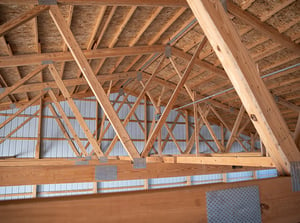 If you’re going to invest your money in a new structure, then you’ll have to make sure it’s engineered to handle various stresses. For instance, your pole barn will inevitably encounter inclement weather (e.g., rain, snow, and wind). How your post frame building reacts to these situations will determine its lifetime.
If you’re going to invest your money in a new structure, then you’ll have to make sure it’s engineered to handle various stresses. For instance, your pole barn will inevitably encounter inclement weather (e.g., rain, snow, and wind). How your post frame building reacts to these situations will determine its lifetime.
Rafters
As mentioned above, rafters are generally built piece-by-piece on site. Similar to all types of construction, how this is done depends on the workers’ skills.
However, since rafters are constructed on-site, you also take a chance of having your lumber exposed to inclement weather, which could degrade the quality of the lumber.
You will also need to consider bird prevention with rafters. Since rafters are open on the bottom, this creates the perfect spot for birds to nest. One way around this would be to install bird netting.
You also need to be careful with thermal ventilation when you use rafters. Rafters are meant to be open on the bottom. Finishing the underside of the rafter could cause ripple effects.
Trusses
Having well-designed trusses is essential because others will follow pursuit if one fails. This domino effect results in building collapse.
To avoid truss failure, we recommend that you consider the following steps:
- Select a professional builder whose truss plant is certified by a third-party inspection service
- Check that your trusses are job ordered and engineered for your pole barn
- Choose high-grade or Machine-Stress Rated (MSR) lumber (if applicable)
- Use heavy-duty steel plates to conjoin the lumber at critical points
It’s important to note that trusses are only one part of the overall building system. The entire post frame structure must be designed to handle multiple stresses. As a result, you can have the most robust truss system, and your pole barn can still fail.
4) Overall Design
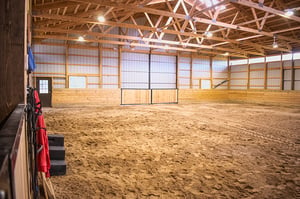 The overall look and feel of your building will be dependent on the design. Consider the following questions to help you:
The overall look and feel of your building will be dependent on the design. Consider the following questions to help you:
- What will the primary use be?
- How much space do you need?
- What will the building flow look like in the interior of the building?
- Do you need additional storage (like a loft or attic space)?
If you want a lot of open space in your building, rafters will not give you that. However, if you decide to use rafters, you will need to make sure you have interior support or additional headers.
On the other hand, Trusses will allow your building to span longer distances without having support underneath them. In addition, the absence of load-bearing walls makes it easy for the interior of a building to be modified for different uses.
5) Engineer's Expertise
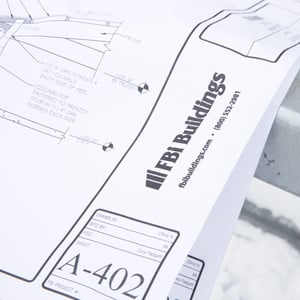 The knowledge of truss design and grading stems from engineering expertise.
The knowledge of truss design and grading stems from engineering expertise.
Civil engineering refers to the design, construction, and maintenance of buildings and infrastructure that make up our world. Typical duties of a civil engineer include:
- Analyze reports, maps, and other data to help plan projects
- Consider costs, regulations, environmental hazards, and other risk factors when planning a project
- Verify and submit permit applications to local, state, and federal agencies
- Provide estimates (i.e., materials, equipment, and labor) to determine project costs
- Test materials used in building projects
- Use software to plan and design structures that line up with industry and government standards
Some post frame companies hire external engineers. FBi recommends working with builders who have licensed engineers on staff because outside firms don’t always have the customer’s best interest at heart.
Whereas internal engineers work with you throughout the project. They think creatively and strategically to provide a better end product for the customer.
The FBi design and engineering department include four individuals with engineering degrees. They work closely with our salespeople to help determine design requirements while meeting customers’ needs and wants.
If you are an avid DIY’er and looking to put up a small, backyard shed you could buy the material at your local lumberyard and build your own rafters.
6) Access to The Job Site
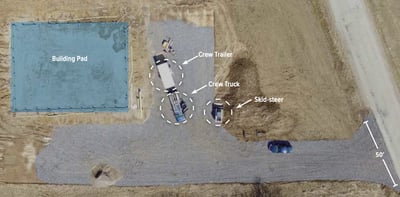 Have you thought about how your builder will access your site when they deliver your material (specifically unloading your trusses)? Is your site free of debris so their equipment won’t get stuck? Will they have enough room to maneuver their heavy equipment?
Have you thought about how your builder will access your site when they deliver your material (specifically unloading your trusses)? Is your site free of debris so their equipment won’t get stuck? Will they have enough room to maneuver their heavy equipment?
Good site access allows equipment and materials to be delivered quickly and efficiently.
Factors to Consider for Site Access:
- Road, driveway, and culvert width
- Location of mailbox
- Location of power lines
- Location of existing buildings, bins, etc.
- Location of trees
- Turning radius of semis
For most post frame building projects, the trusses will need to be transported by semi to the project site and put into place with the help of a lift or a crane. Determining lift points and using the correct equipment is crucial for a successful installation. When done right, the roofing system of your pole barn will be just as secure as that of a steel building.
Rafters might make the most sense for your project if you have tighter site access (and a smaller building project).
Will Your Pole Barn Have Rafters or Trusses?
We understand that was a lot of information to absorb. However, if there’s one thing we want you to take away from this reading, it’s that trusses are ideal for customers interested in an open-concept and uniquely designed building.
If you choose rafters, you’ll still get a spacious structure, but trusses will offer you more flexibility.
Are you ready to build a pole barn? You can design your building with our 3D design tool. Then, save, print, or email your floor plan to family and friends.
Are you ready for a quote? Submit your design to us, and a member of our sales team will call you to begin the estimating process.
Sources:
Rafters vs. Trusses: What’s the Difference?
Do you have more questions that are not covered in this article? If you need help designing and planning, please contact FBi Buildings at 800.552.2981 or click here to email us. If you are ready to get a price, click here to request a quote and a member of our customer engagement team will help you determine the next steps of your project.
